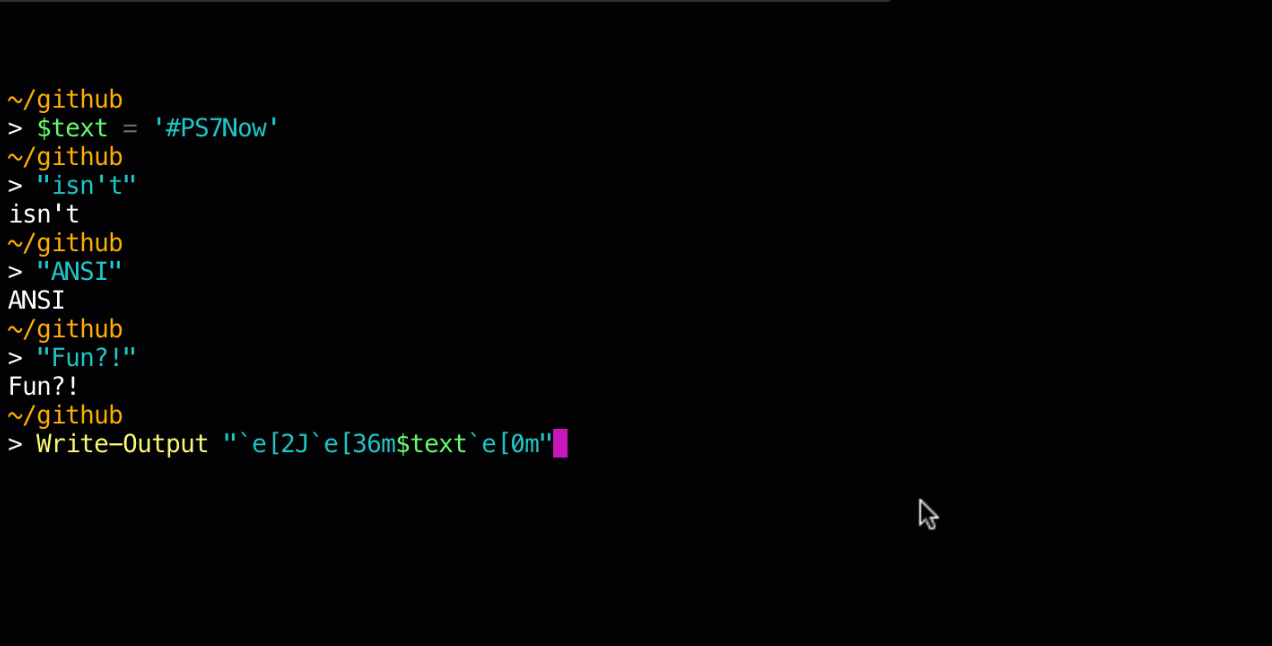
- #Test for ansi escape sequences software
- #Test for ansi escape sequences iso
- #Test for ansi escape sequences plus
- #Test for ansi escape sequences series
#Test for ansi escape sequences software
The popularity of these gradually led to more and more software (especially bulletin board systems and other online services) assuming the escape sequences worked, leading to almost all new terminals and emulator programs supporting them. Others included the Qume QVT-108, Televideo TVI-970, Wyse WY-99GT as well as optional "VT100" or "VT103" or "ANSI" modes with varying degrees of compatibility on many other brands. This model was very successful in the market, which sparked a variety of VT100 clones, among the earliest and most popular of which was the much more affordable Zenith Z-19 in 1979. The first popular video terminal to support these sequences was the Digital VT100, introduced in 1978. In 1994, ANSI withdrew its standard in favor of the international standard.
#Test for ansi escape sequences iso
These two standards were merged into an international standard, ISO 6429. The ANSI X3L2 committee collaborated with the ECMA committee TC 1 to produce nearly identical standards. The name "ANSI escape sequence" dates from 1979 when ANSI adopted ANSI X3.64.
#Test for ansi escape sequences series
It was a continuation of a series of character coding standards, the first one being ECMA-6 from 1965, a 7-bit standard from which ISO 646 originates.

The first standard in the series was ECMA-48, adopted in 1976. The ANSI standard attempted to address these problems by making a command set that all terminals would use and requiring all numeric information to be transmitted as ASCII numbers. In addition, many of these terminals required sending numbers (such as row and column) as the binary values of the characters for some programming languages, and for systems that did not use ASCII internally, it was often difficult to turn a number into the correct character. While the two terminals had identical functionality in this regard, different control sequences had to be used to invoke them.Īs these sequences were different for different terminals, elaborate libraries such as termcap ("terminal capabilities") and utilities such as tput had to be created so programs could use the same API to work with any terminal. The Hazeltine 1500 had a similar feature, invoked using ~, DC1 and then the X and Y positions separated with a comma.
#Test for ansi escape sequences plus
One example is the VT52 terminal, which allowed the cursor to be placed at an x,y location on the screen by sending the ESC character, a Y character, and then two characters representing numerical values equal to the x,y location plus 32 (thus starting at the ASCII space character and avoiding the control characters). They are used in development, scientific, commercial text-based applications as well as bulletin board systems to offer standardized functionality.Īlthough hardware text terminals have become increasingly rare in the 21st century, the relevance of the ANSI standard persists because a great majority of terminal emulators and command consoles interpret at least a portion of the ANSI standard.Īlmost all manufacturers of video terminals added vendor-specific escape sequences to perform operations such as placing the cursor at arbitrary positions on the screen. The terminal interprets these sequences as commands, rather than text to display verbatim.ĪNSI sequences were introduced in the 1970s to replace vendor-specific sequences and became widespread in the computer equipment market by the early 1980s.

Certain sequences of bytes, most starting with an ASCII escape character and a bracket character, are embedded into text. They likely detect the redirection of their output to a file using the isatty function, and do something different depending on whether the output is to a terminal, or to a file.ANSI escape sequences are a standard for in-band signaling to control cursor location, color, font styling, and other options on video text terminals and terminal emulators.

The behavior of ls and vi (and other programs) regarding ANSI control sequences which would be embedded in their output depends upon the design of the program.

By the way, though widely implemented, it does not appear to be documented in POSIX signal.h. See for example Get width/height of a terminal window in c++?. Programs (such as vi) which automatically adjust to screen resizing are responding to the SIGWINCH signal, and using a system call to obtain the system's information about the screen-size.


 0 kommentar(er)
0 kommentar(er)
